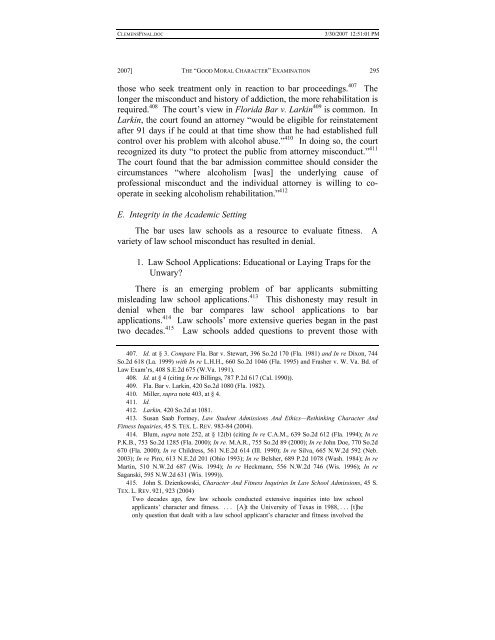Facing the Klieg Lights: Understanding the "Good Moral Character"
Facing the Klieg Lights: Understanding the "Good Moral Character"
Facing the Klieg Lights: Understanding the "Good Moral Character"
Create successful ePaper yourself
Turn your PDF publications into a flip-book with our unique Google optimized e-Paper software.
CLEMENSFINAL.DOC<br />
3/30/2007 12:51:01 PM<br />
2007] THE “GOOD MORAL CHARACTER” EXAMINATION 295<br />
those who seek treatment only in reaction to bar proceedings. 407 The<br />
longer <strong>the</strong> misconduct and history of addiction, <strong>the</strong> more rehabilitation is<br />
required. 408 The court’s view in Florida Bar v. Larkin 409 is common. In<br />
Larkin, <strong>the</strong> court found an attorney “would be eligible for reinstatement<br />
after 91 days if he could at that time show that he had established full<br />
control over his problem with alcohol abuse.” 410 In doing so, <strong>the</strong> court<br />
recognized its duty “to protect <strong>the</strong> public from attorney misconduct.” 411<br />
The court found that <strong>the</strong> bar admission committee should consider <strong>the</strong><br />
circumstances “where alcoholism [was] <strong>the</strong> underlying cause of<br />
professional misconduct and <strong>the</strong> individual attorney is willing to cooperate<br />
in seeking alcoholism rehabilitation.” 412<br />
E. Integrity in <strong>the</strong> Academic Setting<br />
The bar uses law schools as a resource to evaluate fitness. A<br />
variety of law school misconduct has resulted in denial.<br />
1. Law School Applications: Educational or Laying Traps for <strong>the</strong><br />
Unwary?<br />
There is an emerging problem of bar applicants submitting<br />
misleading law school applications. 413 This dishonesty may result in<br />
denial when <strong>the</strong> bar compares law school applications to bar<br />
applications. 414 Law schools’ more extensive queries began in <strong>the</strong> past<br />
two decades. 415 Law schools added questions to prevent those with<br />
407. Id. at § 3. Compare Fla. Bar v. Stewart, 396 So.2d 170 (Fla. 1981) and In re Dixon, 744<br />
So.2d 618 (La. 1999) with In re L.H.H., 660 So.2d 1046 (Fla. 1995) and Frasher v. W. Va. Bd. of<br />
Law Exam’rs, 408 S.E.2d 675 (W.Va. 1991).<br />
408. Id. at § 4 (citing In re Billings, 787 P.2d 617 (Cal. 1990)).<br />
409. Fla. Bar v. Larkin, 420 So.2d 1080 (Fla. 1982).<br />
410. Miller, supra note 403, at § 4.<br />
411. Id.<br />
412. Larkin, 420 So.2d at 1081.<br />
413. Susan Saab Fortney, Law Student Admissions And Ethics—Rethinking Character And<br />
Fitness Inquiries, 45 S. TEX. L. REV. 983-84 (2004).<br />
414. Blum, supra note 252, at § 12(b) (citing In re C.A.M., 639 So.2d 612 (Fla. 1994); In re<br />
P.K.B., 753 So.2d 1285 (Fla. 2000); In re. M.A.R., 755 So.2d 89 (2000); In re John Doe, 770 So.2d<br />
670 (Fla. 2000); In re Childress, 561 N.E.2d 614 (Ill. 1990); In re Silva, 665 N.W.2d 592 (Neb.<br />
2003); In re Piro, 613 N.E.2d 201 (Ohio 1993); In re Belsher, 689 P.2d 1078 (Wash. 1984); In re<br />
Martin, 510 N.W.2d 687 (Wis. 1994); In re Heckmann, 556 N.W.2d 746 (Wis. 1996); In re<br />
Saganski, 595 N.W.2d 631 (Wis. 1999)).<br />
415. John S. Dzienkowski, Character And Fitness Inquiries In Law School Admissions, 45 S.<br />
TEX. L. REV. 921, 923 (2004)<br />
Two decades ago, few law schools conducted extensive inquiries into law school<br />
applicants’ character and fitness. . . . [A]t <strong>the</strong> University of Texas in 1988, . . . [t]he<br />
only question that dealt with a law school applicant’s character and fitness involved <strong>the</strong>
















